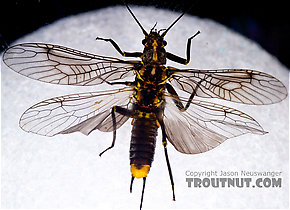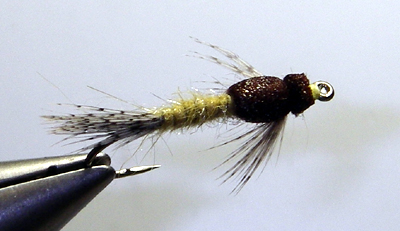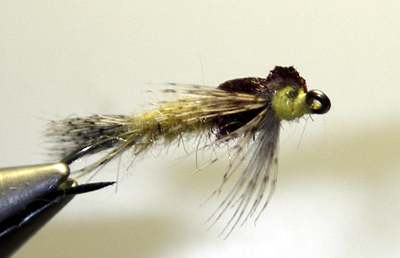Blog & Latest Updates
Fly Fishing Articles
Insects by Common Name


> > Gorgeous photos!
The Specimen
Helopicus subvarians (Springfly) Stonefly Adult View 11 PicturesI caught this female during her egg-laying flight.
View 11 PicturesI caught this female during her egg-laying flight.
 View 11 PicturesI caught this female during her egg-laying flight.
View 11 PicturesI caught this female during her egg-laying flight.Collected June 7, 2007 from the West Branch of the Delaware River in New York
Added to Troutnut.com by on June 8, 2007
Added to Troutnut.com by on June 8, 2007
The Discussion
| Jmd123 | August 26th, 2009, 12:42 pm | |
| Oscoda, MI Posts: 2611 | What a beautiful insect! You know, I feel sorry for all of those people who hate and fear six-legged creatures - they have no idea what wonders and treasures they are missing. Of course, my M.S. in entomology may bias my opinion... Jonathon | |
| No matter how big the one you just caught is, there's always a bigger one out there somewhere... | ||
| Gutcutter | November 9th, 2010, 9:51 am | |
| Pennsylvania Posts: 470 | does anyone out there know what the nymph looks like for this stonefly? just basic colors. i ran into a hatch this past spring and did well with a generic montana nymph, but would like to tie something a bit more accurate. not necessarily for the trout but for me. the hatch was on a freestone in north central pa. slatedrake - this was in your neck of the woods - any thoughts? | |
| All men who fish may in turn be divided into two parts: those who fish for trout and those who don't. Trout fishermen are a race apart: they are a dedicated crew- indolent, improvident, and quietly mad. -Robert Traver, Trout Madness | ||
| Taxon | November 9th, 2010, 1:16 pm | |
Site Editor Royse City, TXPosts: 1350 | Tony, Here is a photo taken by Tom Murray of a Helopicus subvarians nymph from W. MA. It was identified by Dr. Donald S. Chandler at UNH:  | |
| Best regards, Roger Rohrbeck www.FlyfishingEntomology.com | ||
| Gutcutter | November 9th, 2010, 3:24 pm | |
| Pennsylvania Posts: 470 | thank you roger that is not what i would have thought it looked like. i would have guessed an overall dark color. it will be interesting to see what i come up with and how they work as compared to the old standby montana nymph. anybody have any immediate ideas for materials? | |
| All men who fish may in turn be divided into two parts: those who fish for trout and those who don't. Trout fishermen are a race apart: they are a dedicated crew- indolent, improvident, and quietly mad. -Robert Traver, Trout Madness | ||
| Taxon | November 9th, 2010, 8:06 pm | |
Site Editor Royse City, TXPosts: 1350 | Gutcutter sent me two photos of a nymph he had tied, and asked me to post them for him. I took the liberty of cropping, resizing, and color correcting the photos:  | |
| Best regards, Roger Rohrbeck www.FlyfishingEntomology.com | ||
| PaulRoberts | November 10th, 2010, 10:32 am | |
| Colorado Posts: 1776 | Nice, Tony! Is that foam for the "wing cases"? Chamois? Bugskin? I found a nice material I like for nymphs, and it makes decent stonefly patterns. The material is called "plastic canvas" yarn. It's a nylon yarn you can get at craft stores, comes in lots of colors, and is cheap. It's translucent so it looks like tissue and chitin. I use an off-white or pale yellow for the ventral side, then pull a length of contrasting color for the dorsal side. I rib the abdomen with wire and then pinch the abdomen to make it dorso-ventrally flattened. Contrasty details are added with a very fine point indelible marker (drafting pen), and with vinyl fabric paint for eyes and on the thoracic plates. The nylon holds the color pretty well, and they can be touched up later. Tails and legs I use vary, and seem to matter little. When I tied these, rubber legs fine enough weren't available -I believe that's changed and there are some nice variegated materials out there. I've also used feather barbs. Regardless, that may just be human eye candy -tufts of fuzz work just fine -it's the body shape, size and shades that I think matter most. The picked out fuzzy legs also stabilize the fly on the drift and with the flat abdomen it planes on the drift with a nice upright, slightly tail down attitude -although real stoneflies dislodged get to bottom very quickly swimming with a head down attitude with legs a-flailing in a notable wave-like pattern of motion. Impressive swimmers. To mimic this I saw a pattern that used rabbit fur for legs that rippled in that wave pattern. I never worked with that though. That with lead eyes, or a jig head, might make the ultimate dislodged stone. My simpler versions below have worked really well for me though. Anyway, the body material is pretty cool, and you could go much more realistic if you wanted to get fancy. Here are some already tied, and fished, from my nymph box.  | |
| Shawnny3 | November 10th, 2010, 2:50 pm | |
Moderator Pleasant Gap, PAPosts: 1197 | Nice flies, Tony and Paul.although real stoneflies dislodged get to bottom very quickly swimming with a head down attitude with legs a-flailing in a notable wave-like pattern of motion. I've never observed this before, but it makes sense and I trust the observation. If they indeed tend to swim face-down, might not a backwards-tied version be something to try? -Shawn | |
| Jewelry-Quality Artistic Salmon Flies, by Shawn Davis www.davisflydesigns.com | ||
| PaulRoberts | November 10th, 2010, 3:20 pm | |
| Colorado Posts: 1776 | Shawn, It's pretty easy to see. Catch one (a larger golden stone) and drop it in the water. As I remember it, they tuck their heads (for the hydrofoil effect) then kick like mad with their legs. I wonder if the flattened legs are acting like paddles? Oh I see...no they don't swim face down but pointed down toward the substrate, head leading the way. I think I've seen Epeorus and maybe Stenonema do this too. Anyone else? | |
| Gutcutter | November 14th, 2010, 6:04 pm | |
| Pennsylvania Posts: 470 | paul the wingcase is dark brown foam. i usually tie stoneflies with spun deerhair for the thorax, but i substituted foam for this fly. we'll see how it works this spring. when i drag stoneflies, i find that they get hung up more than mayflies. i hate spending more than a few minutes tying a pattern that i may loose a half dozen in a morning. i like the stonefly nymph to be a bit buoyant and drift a few inches above the shot. i leave my barrel knot tag long and put the shot on there instead of on the tippett. although i still lose some, not as many. interesting point about the stonefly's attitude while adrift. i wonder if the head of the fly is pulled into that down position when the shot is ahead and the fly drifts behind with the life preserver wing case. i will have to look at that in a clear pool this coming spring... the nymph pattern that roger kindly posted for me takes about 4 minutes to tie. | |
| All men who fish may in turn be divided into two parts: those who fish for trout and those who don't. Trout fishermen are a race apart: they are a dedicated crew- indolent, improvident, and quietly mad. -Robert Traver, Trout Madness | ||
| PaulRoberts | November 15th, 2010, 10:26 am | |
| Colorado Posts: 1776 | As to the "drift posture" of stoneflies –they use that "skiddle to the bottom” in order to get to the bottom -fast! Impressive. So it's not a "drift posture" bc they aren't up in the drift for long. They are able to get to bottom fast. I'm talking about the larger golden stones that do this. I don't remember what the smaller ones do –my guess is most are in trouble if they get too far above the boundary layer. Pteronarcys though, doesn't do this –drop em in and they roll up and tumble; Lethargic things. I'm pretty sure that some clinger mays can do this swimming thing too. It would be in my journals somewhere, but I have no idea where. Will play with it some more when we get open and maybe warmer water. | |
| SlateDrake9 | November 19th, 2010, 7:43 am | |
| Potter County, PA Posts: 144 | Gutcutter, I use a very generic brown stonefly nymph pattern with excellent results. Sometimes I use a very large PT nymph with equal results when these guys are in migration. I believe many folks greatly over estimate the need for an exacting pattern and then get angry when they loose a half dozen flies that took 45 minutes each to tie. Stick with KISS and you'll catch a ton of trout and have more time to fish since you're spending less time tying. Just my $.02 | |
| Fishing with bait is like swearing in church. -- Slate Drake | ||
| Oldredbarn | November 19th, 2010, 8:24 am | |
| Novi, MI Posts: 2608 | Sometimes I use a very large PT nymph with equal results when these guys are in migration. BJ, I use a light and dark version of a Hare's Ear...Same deal...I know folks will tell you that the fish gets a pretty good look at a fly below the surface, but as you say, when these bugs are migrating or during drift periods, I think it's difficult for a trout to pass a close approximation up. My nickels worth says that a trout gets a little geeked or pumped up during such activity and is in an aggressive frame of mind and more likely to hit something and think about it later. Spence | |
| "Even when my best efforts fail it's a satisfying challenge, and that, after all, is the essence of fly fishing." -Chauncy Lively "Envy not the man who lives beside the river, but the man the river flows through." Joseph T Heywood | ||
| PaulRoberts | November 19th, 2010, 8:25 am | |
| Colorado Posts: 1776 | I agree that realism -in hand -doesn't tend to add much to a fly's effectiveness. But there are certain attributes that can make a fly extraordinarily effective in context. It can be really simple. One of my first introductions to "selectivity", or at least trout's ability to recognize "food" on the drift, came years ago when I discovered my first Hendrickson emergence. It was unseasonably cold and no fish were rising. Not knowing what the nymph looked like I chose something close to the duns I could see –a pale bodied nymph. It failed epically LOL! I did a little research and found out the nymphs were a dark chocolate color. I tied up some crude ties with brown wool and MAN! what a difference. I’ve had many such situations where presenting “FOOD!” made an enormous difference. Like 20:1! Here’s one standout example -when I first discovered the importance of hellgrammites in one particular stream: I fished through a stretch with a big buggy stonefly pattern catching one 14” trout. I turned around and retraced my steps with a hellgrammite pattern and caught, I don’t remember, at least a dozen –including a 15, four 17s, and a 19incher! I could repeat that performance too and took browns, during that window over the several years I lived there, up to 23”. There are other such scenarios out there just waiting for us. The difference seems to be this: If the fish are truly selective, they may simply ignore your fly –or more often, not even have it register. It's in the "not food" category. IME, this is more rare on smaller or less fertile waters and any old fly well presented will turn heads. But if the fish are on to a a certain search image, even on small infertile waters –say a Hendrickson nymph –then a very dark #14 nymph is going to say "FOOD!" –and from a distance. This turned out to be the big difference IME –the distance trout would move for a fly. With an appropriate pattern tied on I didn't have to hit the fish on the nose. In my mind, if you are doing well enough on a PT during pale-bellied stonefly activity, then you don't need the stonefly tie to begin with. | |
| Entoman | January 29th, 2011, 2:31 am | |
| Northern CA & ID Posts: 2604 | Paul and Tony - Nice flies! There's a really great material for scud back, caddis larva, and small stones. It's kinda foggy transparent and takes markers really well if your looking for that two tone effect. Either way it looks great ribbed w/ mono. Doesn't rot like latex and it's tough as nails. Looks a lot more natural than strips of plastic bag, and the price is right too. Your Cheerios come in it... In my neck of the woods, the Perlodids(little yellow stones) will drive you nuts because they usually hatch on early Summer evenings in complex hatches together with PMD's and too many little caddis species to keep score, especially on the Truckee. But sometimes the fish will really hone in on them. These guys can swim! Maybe not as fast as the Baetids, but pretty damn quick. I'm convinced that several species can and do emerge by swimming to the surface like many mayflies. Whether they do this as as adults, Heptageniid fashion or has nymphs, I'm not sure. Some guys do really well with the good old Light Cahill wet. I prefer fishing a nymph, dead drift just under the surface or on a controlled swing. I don't worry too much about imitating them swimming down for cover because their availability to the fish is when they're either drifting along the bottom to relocate or swimming to the surface or shore to hatch anyway. Really important that the fly fishes upright when fishing it near the surface so there are a lot of design features in it to make sure it does so. I wish I wasn't so camera challenged right now because I'd like to show you the fly I use for this hatch. I'm working on it. For fishing deep dead drift, its hard to beat Mike Mercer's B.H. Biot Stone if you haven't tried it. Kurt | |
| "It's not that I find fishing so important, it's just that I find all other endeavors of Man equally unimportant... And not nearly as much fun!" Robert Traver, Anatomy of a Fisherman | ||
Quick Reply
You have to be logged in to post on the forum. It's this easy:
Related Discussions
| Title | Replies | Last Reply |
| Re: Wiggle Nymphs In General Discussion by Martinlf | 2 | Apr 28, 2007 by Martinlf |
| Re: Pteronarcys dorsata In Pteronarcys dorsata Stonefly Nymph by Wiflyfisher | 2 | Nov 10, 2021 by Troutnut |
| Re: Hatching of Early Black Stoneflies In General Discussion by Zugbuggin | 1 | Mar 9, 2012 by Wiflyfisher |
| Re: comparison In General Discussion by Blackghost | 4 | May 3, 2009 by Wbranch |
| Re: steelhead and flow rates In General Discussion by Ike | 2 | Mar 6, 2013 by Kschaefer3 |
| A "hatching" mouse In General Discussion by Troutnut | 0 | |
| Re: Drifting Drunella Underwater In General Discussion by PaulRoberts | 2 | Feb 23, 2013 by Entoman |
| Re: Deep water trout and insects. In General Discussion by Crooketarow | 1 | Jul 9, 2009 by Mike56 |
| Re: confusing fish behavior In General Discussion by Wwelz | 2 | Jun 26, 2008 by Wwelz |
| Re: La Fontaine Caddis patterns In General Discussion by Goose | 3 | Oct 19, 2006 by GONZO |
Troutnut.com is copyright © 2004-2024 Jason
Neuswanger (email Jason). See my FAQ for information about use of my images.
 privacy policy
privacy policy






